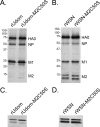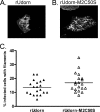Palmitoylation of the influenza A virus M2 protein is not required for virus replication in vitro but contributes to virus virulence
- PMID: 19553312
- PMCID: PMC2738213
- DOI: 10.1128/JVI.01129-09
Palmitoylation of the influenza A virus M2 protein is not required for virus replication in vitro but contributes to virus virulence
Abstract
The influenza A virus M2 protein has important roles during virus entry and in the assembly of infectious virus particles. The cytoplasmic tail of the protein can be palmitoylated at a cysteine residue, but this residue is not conserved in a number of human influenza A virus isolates. Recombinant viruses encoding M2 proteins with a serine substituted for the cysteine at position 50 were generated in the A/WSN/33 (H1N1) and A/Udorn/72 (H3N2) genetic backgrounds. The recombinant viruses were not attenuated for replication in MDCK cells, Calu-3 cells, or in primary differentiated murine trachea epithelial cell cultures, indicating there was no significant contribution of M2 palmitoylation to virus replication in vitro. The A/WSN/33 M2C50S virus displayed a slightly reduced virulence after infection of mice, suggesting that there may be novel functions for M2 palmitoylation during in vivo infection.
Figures





Similar articles
-
PB2 residue 271 plays a key role in enhanced polymerase activity of influenza A viruses in mammalian host cells.J Virol. 2010 May;84(9):4395-406. doi: 10.1128/JVI.02642-09. Epub 2010 Feb 24. J Virol. 2010. PMID: 20181719 Free PMC article.
-
In vitro and in vivo replication of influenza A H1N1 WSN33 viruses with different M1 proteins.J Gen Virol. 2013 Apr;94(Pt 4):884-895. doi: 10.1099/vir.0.046219-0. Epub 2012 Dec 19. J Gen Virol. 2013. PMID: 23255622 Free PMC article.
-
Key Amino Acids of M1-41 and M2-27 Determine Growth and Pathogenicity of Chimeric H17 Bat Influenza Virus in Cells and in Mice.J Virol. 2021 Sep 9;95(19):e0101921. doi: 10.1128/JVI.01019-21. Epub 2021 Sep 9. J Virol. 2021. PMID: 34287044 Free PMC article.
-
Extending the cytoplasmic tail of the influenza a virus M2 protein leads to reduced virus replication in vivo but not in vitro.J Virol. 2008 Jan;82(2):1059-63. doi: 10.1128/JVI.01499-07. Epub 2007 Nov 7. J Virol. 2008. PMID: 17989186 Free PMC article.
-
Palmitoylation of virus proteins.Biol Cell. 2012 Sep;104(9):493-515. doi: 10.1111/boc.201200006. Epub 2012 Jul 17. Biol Cell. 2012. PMID: 22548323 Free PMC article. Review.
Cited by
-
Recombinant influenza A H3N2 viruses with mutations of HA transmembrane cysteines exhibited altered virological characteristics.Virus Genes. 2014 Apr;48(2):273-82. doi: 10.1007/s11262-013-1011-2. Epub 2013 Nov 23. Virus Genes. 2014. PMID: 24272698
-
Evaluation of the Calu-3 cell line as a model of in vitro respiratory syncytial virus infection.J Virol Methods. 2011 Jun;174(1-2):144-9. doi: 10.1016/j.jviromet.2011.03.027. Epub 2011 Mar 31. J Virol Methods. 2011. PMID: 21458491 Free PMC article.
-
Cyclic Alopecia and Abnormal Epidermal Cornification in Zdhhc13-Deficient Mice Reveal the Importance of Palmitoylation in Hair and Skin Differentiation.J Invest Dermatol. 2015 Nov;135(11):2603-2610. doi: 10.1038/jid.2015.240. Epub 2015 Jun 29. J Invest Dermatol. 2015. PMID: 26121212
-
Coupling high-throughput genetics with phylogenetic information reveals an epistatic interaction on the influenza A virus M segment.BMC Genomics. 2016 Jan 12;17:46. doi: 10.1186/s12864-015-2358-7. BMC Genomics. 2016. PMID: 26754751 Free PMC article.
-
Role of Host-Mediated Post-Translational Modifications (PTMs) in RNA Virus Pathogenesis.Int J Mol Sci. 2020 Dec 30;22(1):323. doi: 10.3390/ijms22010323. Int J Mol Sci. 2020. PMID: 33396899 Free PMC article. Review.
References
-
- Benton, K. A., J. A. Misplon, C. Y. Lo, R. R. Brutkiewicz, S. A. Prasad, and S. L. Epstein. 2001. Heterosubtypic immunity to influenza A virus in mice lacking IgA, all Ig, NKT cells, or gamma delta T cells. J. Immunol. 1667437-7445. - PubMed
-
- Castrucci, M. R., M. Hughes, L. Calzoletti, I. Donatelli, K. Wells, A. Takada, and Y. Kawaoka. 1997. The cysteine residues of the M2 protein are not required for influenza A virus replication. Virology 238128-134. - PubMed
-
- Centers for Disease Control and Prevention. 2009. Swine influenza A (H1N1) infection in two children—Southern California, March-April 2009. MMWR Morb. Mortal. Wkly. Rep. 58400-402. - PubMed
Publication types
MeSH terms
Substances
Grants and funding
LinkOut - more resources
Full Text Sources

